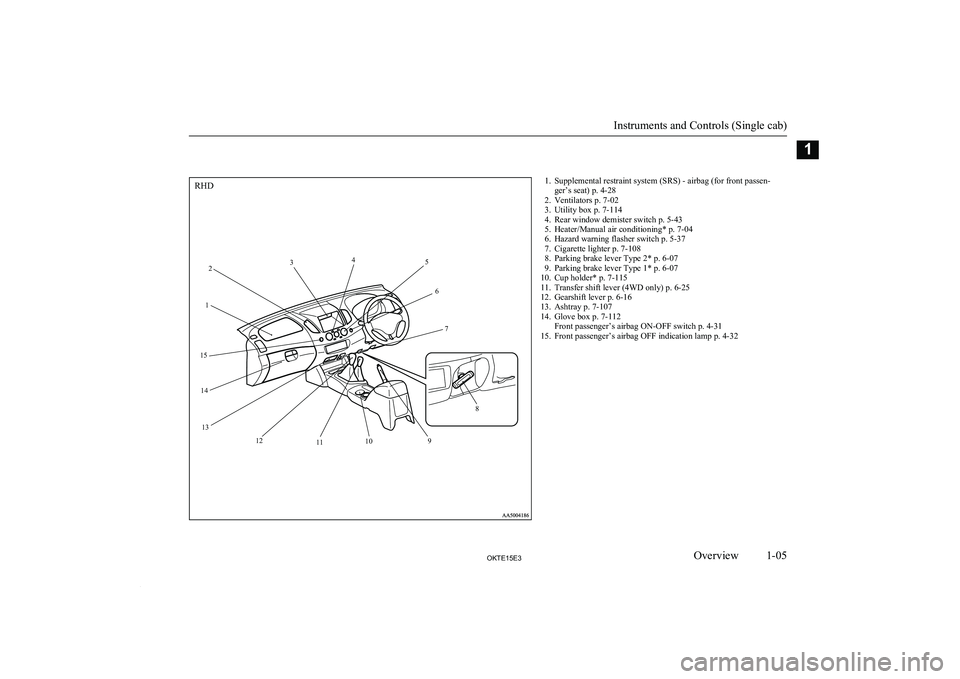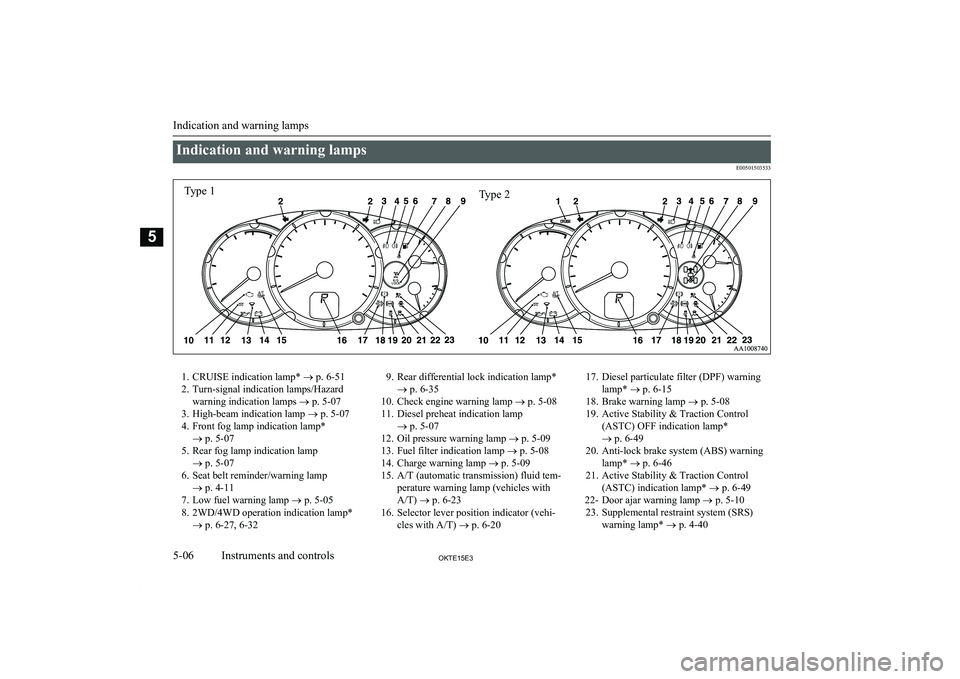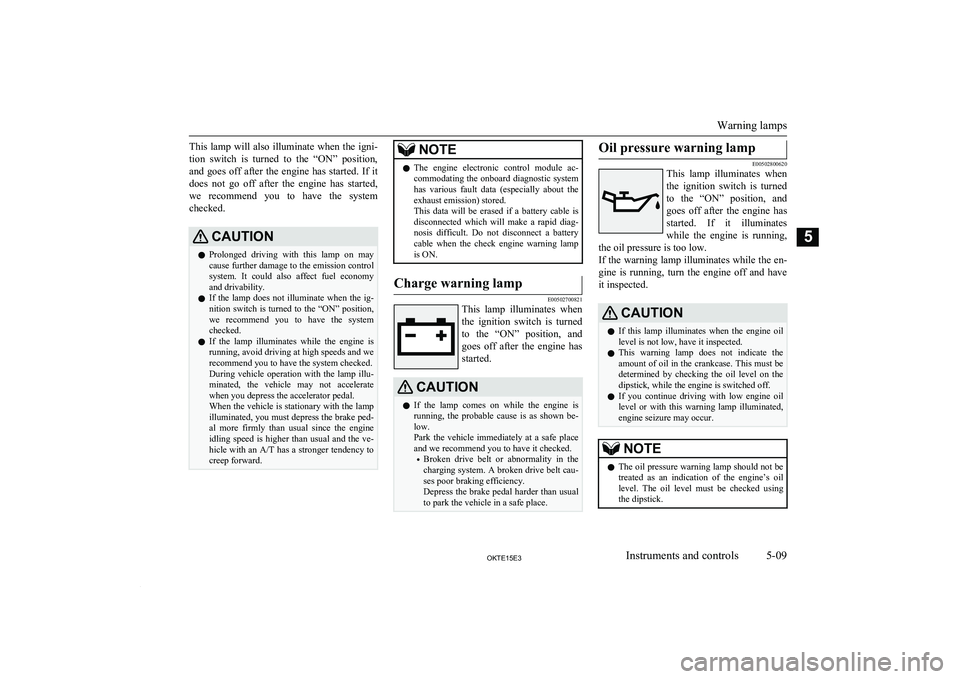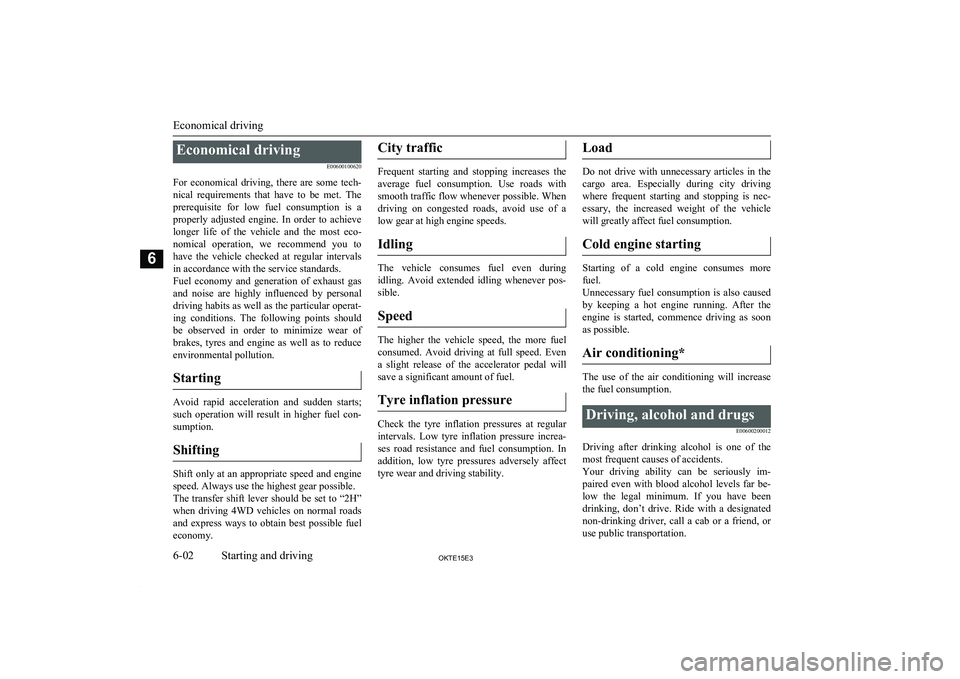brake MITSUBISHI L200 2015 Owner's Manual (in English)
[x] Cancel search | Manufacturer: MITSUBISHI, Model Year: 2015, Model line: L200, Model: MITSUBISHI L200 2015Pages: 418, PDF Size: 25.8 MB
Page 6 of 418

Instruments and Controls (Single cab)E001001061481. Hazard warning flasher switch p. 5-37
2. Heater/Manual air conditioning* p. 7-04
3. Rear window demister switch p. 5-43
4. Utility box p. 7-114
5. Ventilators p. 7-02
6. Supplemental restraint system (SRS) - airbag (for front passen- ger’s seat)* p. 4-28
7. Front passenger’s airbag OFF indication lamp* p. 4-32
8. Glove box p. 7-112 Front passenger’s airbag ON-OFF switch* p. 4-31
9. Cigarette lighter p. 7-108
10. Gearshift lever p. 6-16
11. Transfer shift lever (4WD only) p. 6-25
12. Cup holder* p. 7-115
13. Parking brake lever Type 1* p. 6-07
14. Parking brake lever Type 2* p. 6-07
15. Ashtray p. 7-107
Instruments and Controls (Single cab)
1-04OKTE15E3Overview112
3
4
5
6
78
9
10
11
12
13
14 15
LHD
Page 7 of 418

1. Supplemental restraint system (SRS) - airbag (for front passen-ger’s seat) p. 4-28
2. Ventilators p. 7-02
3. Utility box p. 7-114
4. Rear window demister switch p. 5-43
5. Heater/Manual air conditioning* p. 7-04
6. Hazard warning flasher switch p. 5-37
7. Cigarette lighter p. 7-108
8. Parking brake lever Type 2* p. 6-07
9. Parking brake lever Type 1* p. 6-07
10. Cup holder* p. 7-115
11. Transfer shift lever (4WD only) p. 6-25
12. Gearshift lever p. 6-16
13. Ashtray p. 7-107
14. Glove box p. 7-112 Front passenger’s airbag ON-OFF switch p. 4-31
15. Front passenger’s airbag OFF indication lamp p. 4-32
Instruments and Controls (Single cab)
1-05OKTE15E3Overview112
3
4
5
6
7
8
9
10
11
12
13
14
15
RHD
Page 8 of 418

Instruments and Controls (Club, Double cab)E001001083021. Rear window demister switch (vehicle with heater/manual air con-ditioning) p. 5-43
2. Utility box* p. 7-114 Centre information display* p. 5-10
Audio* p. 7-51
MITSUBISHI Multi-Communication System*
Refer to the separate “MITSUBISHI Multi-Communication Sys-
tem owner’s manual”
3. Centre information display* p. 5-10
4. Ventilators p. 7-02
5. Supplemental restraint system (SRS) - airbag (for front passen- ger’s seat)* p. 4-28
6. Front passenger’s airbag OFF indication lamp* p. 4-32
7. Glove box p. 7-112 Front passenger’s airbag ON-OFF switch* p. 4-31
USB input terminal* p. 7-103
8. Ashtray (fixed position)* p. 7-107
9. Cigarette lighter p. 7-108
10. Rear retractable power window switch* p. 3-09
11. Transfer shift lever (4WD only) p. 6-25, 6-30
12. Parking brake lever p. 6-07
13. Cup holder p. 7-115
14. Ashtray (moveable)* p. 7-107
15. Front console box* p. 7-113
16. Heated seat switch* p. 4-07
17. Gearshift lever* p. 6-16 Selector lever* p. 6-19
18. Audio* p. 7-15
19. Hazard warning flasher switch p. 5-37
20. Heater/Manual air conditioning* p. 7-04 Automatic air conditioning* p. 7-09
Instruments and Controls (Club, Double cab)
1-06OKTE15E3Overview1LHD
Page 9 of 418

1. Centre information display* p. 5-10
2. Rear window demister switch (vehicle with heater/manual air con- ditioning) p. 5-43
3. Heater/Manual air conditioning* p. 7-04 Automatic air conditioning* p. 7-09
4. Hazard warning flasher switch p. 5-37
5. Audio* p. 7-15
6. Transfer shift lever (4WD only) p. 6-25, 6-30
7. Heated seat switch* p. 4-07
8. Parking brake lever p. 6-07
9. Cup holder p. 7-115
10. Ashtray (moveable)* p. 7-107
11. Gearshift lever* p. 6-16 Selector lever* p. 6-19
12. Front console box* p. 7-113
13. Cigarette lighter p. 7-108
14. Rear retractable power window switch* p. 3-09
15. Glove box p. 7-112 Front passenger’s airbag ON-OFF switch* p. 4-31
USB input terminal* p. 7-103
16. Front passenger’s airbag OFF indication lamp* p. 4-32
17. Supplemental restraint system (SRS) - airbag (for front passen- ger’s seat)* p. 4-28
18. Ventilators p. 7-02
19. Utility box* p. 7-114 Centre information display* p. 5-10
Audio* p. 7-51
MITSUBISHI Multi-Communication System*
Refer to the separate “MITSUBISHI Multi-Communication Sys-
tem owner’s manual”
Instruments and Controls (Club, Double cab)
1-07OKTE15E3Overview1RHD
Page 56 of 418

Seat beltsE00404800825
To protect you and your passengers in the event of an accident, it is most important thatthe seat belts are worn correctly while driv-ing.
A seat belt for a front seat equipped with an
airbag has a pretensioner system. These belts are used the same way as a conventional seatbelt.
Refer to “Seat belt pretensioner system and force limiter system” on page 4-13 .WARNINGl Always place the shoulder belt over your
shoulder and across your chest. Never put it behind you or under your arm.
l One seat belt should be used by only one
person. Doing otherwise can be danger-
ous.
l The seat belt will provide its wearer with
maximum protection if the recliner seat- back is placed in fully upright position.
When the seatback is reclined, there is
greater risk that the passenger will slide
under the belt, especially in a forward im- pact accident, and may be injured by the
belt or by striking the instrument panel or seatbacks.
l Seat belts should always be worn by every
adult who drives or rides in this vehicle, and by all children who are tall enough to
wear seat belts properly.WARNINGl Remove any twists when using the belt.
l No modifications or additions should be
made by the user which will either pre-
vent the seat belt adjusting devices from operating to remove slack, or prevent the
seat belt assembly from being adjusted to
remove slack.
l To reduce risk of serious or fatal injury in
an accident, including the deploying driv-
er’s airbag, adjust the driver’s seat as far back as possible while maintaining a posi- tion that still allows good visibility andgood control of the steering wheel, the
brake and accelerator, and vehicle con- trols.
l Never hold a child in your arms or on
your lap when riding in this vehicle, even if you are wearing your seat belt. To do so
risks severe or fatal injury to the child in a collision or sudden stop.
l Always adjust the seat belt to a snug fit.3-point type seat belt (with
emergency locking mechanism)
E00404901126
This type of belt requires no length adjust-
ment. Once worn, the belt adjusts itself to the
movement of the wearer, but in the event of a sudden or strong shock, the belt automatical-
ly locks to hold the wearer’s body.
NOTEl You can check if the belt locks by pulling it
forward quickly.
To fasten
1. Pull the seat belt out slowly while hold-
ing the latch plate.
NOTEl When the seat belts cannot be pulled out in a
locked condition, pull the belts once force-
fully and then return them. After that, pull
the belts out slowly once again.
2. Insert the latch plate into the buckle until
a “click” is heard.
Seat belts
4-10OKTE15E3Seat and seat belts4
Page 94 of 418

Indication and warning lampsE005015035331. CRUISE indication lamp* ® p. 6-51
2. Turn-signal indication lamps/Hazard warning indication lamps ® p. 5-07
3. High-beam indication lamp ® p. 5-07
4. Front fog lamp indication lamp* ® p. 5-07
5. Rear fog lamp indication lamp ® p. 5-07
6. Seat belt reminder/warning lamp ® p. 4-11
7. Low fuel warning lamp ® p. 5-05
8. 2WD/4WD operation indication lamp* ® p. 6-27, 6-329. Rear differential lock indication lamp*
® p. 6-35
10. Check engine warning lamp ® p. 5-08
11. Diesel preheat indication lamp ® p. 5-07
12. Oil pressure warning lamp ® p. 5-09
13. Fuel filter indication lamp ® p. 5-08
14. Charge warning lamp ® p. 5-09
15. A/T (automatic transmission) fluid tem- perature warning lamp (vehicles with
A/T) ® p. 6-23
16. Selector lever position indicator (vehi- cles with A/T) ® p. 6-2017. Diesel particulate filter (DPF) warning
lamp* ® p. 6-15
18. Brake warning lamp ® p. 5-08
19. Active Stability & Traction Control (ASTC) OFF indication lamp*
® p. 6-49
20. Anti-lock brake system (ABS) warning lamp* ® p. 6-46
21. Active Stability & Traction Control (ASTC) indication lamp* ® p. 6-49
22- Door ajar warning lamp ® p. 5-10
23. Supplemental restraint system (SRS) warning lamp* ® p. 4-40
Indication and warning lamps
5-06OKTE15E3Instruments and controls5Type 1Type 2
Page 96 of 418

Fuel filter indication lamp
E00509900170
This indication lamp illumi-
nates when the ignition switch is turned to the “ON”
position and goes off after the engine has started. If itlights up while the engine is
running, it indicates that water has accumula- ted inside the fuel filter; if this happens, re-
move the water from the fuel filter.
Refer to “Removal of water from the fuel fil- ter” on page 8-06.When the lamp goes out, you can resume
driving. If it either does not go out or comes on from time to time, we recommend you to
have the vehicle inspected.Warning lamps
E00502400017Brake warning lamp
E00502501637
This lamp illuminates whenthe ignition switch is turnedto the “ON” position, and goes off after a few seconds.
Always make sure that the
lamp goes off before driving.
With the ignition switch in the “ON” posi-
tion, the brake warning lamp illuminates un- der the following conditions:
l When the parking brake lever has been
engaged.
l When the brake fluid level in the reser-
voir falls to a low level.
l When the brake force distribution func-
tion is not operating correctly. (vehicles
with anti-lock brake system)CAUTIONl In the situations listed below, brake perform-
ance may be compromised or the vehicle
may become unstable if brakes are applied
suddenly; consequently, avoid driving at high speeds or applying the brakes suddenly.
Furthermore, immediately the vehicle should be brought to a stop in a safe location and to have it checked.
• The brake warning lamp does not illumi-
nate when the parking brake is applied ordoes not turn off when the parking brake is released.
• The ABS warning lamp and brake warn-
ing lamp illuminate at the same time.
For details, refer to “ABS warning lamp”
on page 6-46. (vehicles with anti-lock
brake system)
• The brake warning lamp remains illumi-
nated during driving.
l The vehicle should be brought to a halt in
the following manner when brake perform-
ance has deteriorated.
• Depress the brake pedal harder than usual.
Even if the brake pedal moves down to
the very end of its possible stroke, keep it
pressed down hard.CAUTION• Should the brakes fail, use engine braking
to reduce your speed and carefully pull the parking brake lever to park your vehi-
cle.
Depress the brake pedal to operate the
stop lamp to alert the vehicles behind you.Check engine warning lamp
E00502601944
This lamp is a part of an on-
board diagnostic system
which monitors the emis-
sions, engine and automatic transmission control sys-tems.
If a problem is detected in one of these sys- tems, this lamp illuminates.
Although your vehicle will usually be driva-
ble and not need towing, we recommend you
to have the system checked as soon as possi-
ble.
[Vehicles to comply with the Euro 3 and Eu-
ro 4 regulation]
This lamp will also illuminate for a few sec- onds when the ignition switch is turned to the “ON” position. If it does not go off after a
few seconds, we recommend you to have the vehicle checked.
[Vehicles to comply with the Euro 5+]
Warning lamps
5-08OKTE15E3Instruments and controls5
Page 97 of 418

This lamp will also illuminate when the igni-
tion switch is turned to the “ON” position, and goes off after the engine has started. If it
does not go off after the engine has started,
we recommend you to have the system checked.CAUTIONl Prolonged driving with this lamp on may
cause further damage to the emission control
system. It could also affect fuel economy and drivability.
l If the lamp does not illuminate when the ig-
nition switch is turned to the “ON” position, we recommend you to have the system
checked.
l If the lamp illuminates while the engine is
running, avoid driving at high speeds and we recommend you to have the system checked.
During vehicle operation with the lamp illu-
minated, the vehicle may not accelerate
when you depress the accelerator pedal.
When the vehicle is stationary with the lamp illuminated, you must depress the brake ped- al more firmly than usual since the engine
idling speed is higher than usual and the ve- hicle with an A/T has a stronger tendency to
creep forward.NOTEl The engine electronic control module ac-
commodating the onboard diagnostic system has various fault data (especially about the
exhaust emission) stored.
This data will be erased if a battery cable is
disconnected which will make a rapid diag- nosis difficult. Do not disconnect a batterycable when the check engine warning lamp
is ON.Charge warning lamp
E00502700821
This lamp illuminates when
the ignition switch is turnedto the “ON” position, and goes off after the engine has
started.
CAUTIONl If the lamp comes on while the engine is
running, the probable cause is as shown be-low.
Park the vehicle immediately at a safe place
and we recommend you to have it checked.
• Broken drive belt or abnormality in the
charging system. A broken drive belt cau-
ses poor braking efficiency.
Depress the brake pedal harder than usual
to park the vehicle in a safe place.Oil pressure warning lamp
E00502800620
This lamp illuminates when
the ignition switch is turnedto the “ON” position, and goes off after the engine has
started. If it illuminates
while the engine is running,
the oil pressure is too low.
If the warning lamp illuminates while the en- gine is running, turn the engine off and have
it inspected.
CAUTIONl If this lamp illuminates when the engine oil
level is not low, have it inspected.
l This warning lamp does not indicate the
amount of oil in the crankcase. This must be determined by checking the oil level on the
dipstick, while the engine is switched off.
l If you continue driving with low engine oil
level or with this warning lamp illuminated,
engine seizure may occur.NOTEl The oil pressure warning lamp should not be
treated as an indication of the engine’s oil
level. The oil level must be checked using
the dipstick.
Warning lamps
5-09OKTE15E3Instruments and controls5
Page 133 of 418

Economical driving............................................................................. 6-02
Driving, alcohol and drugs.................................................................. 6-02
Safe driving techniques....................................................................... 6-03
Running-in recommendations............................................................. 6-04 Parking brake...................................................................................... 6-07
Parking................................................................................................ 6-08
Steering wheel height adjustment....................................................... 6-09
Inside rear-view mirror....................................................................... 6-09 Outside rear-view mirrors................................................................... 6-10
Ignition switch.....................................................................................6-12 Steering wheel lock............................................................................. 6-13
Starting................................................................................................ 6-13 Diesel particulate filter (DPF)*........................................................... 6-15Manual transmission........................................................................... 6-16Automatic transmission Sports Mode 4A/T, 5A/T............................. 6-19Easy select 4WD*............................................................................... 6-25
Super select 4WD*..............................................................................6-29
Rear differential lock*........................................................................ 6-34 4-wheel drive operation...................................................................... 6-38
Inspection and maintenance following rough road operation............. 6-41
Cautions on handling of 4-wheel drive vehicles................................. 6-41
Limited-slip differential*.................................................................... 6-43
Braking................................................................................................ 6-43
Brake assist system*........................................................................... 6-44
Anti-lock brake system (ABS)*.......................................................... 6-45
Power steering system.........................................................................6-48 Active Stability & Traction Control (ASTC)*....................................6-48
Cruise control*.................................................................................... 6-50 Cargo loads......................................................................................... 6-55Trailer towing......................................................................................6-55Starting and driving
OKTE15E36
Page 134 of 418

Economical drivingE00600100620
For economical driving, there are some tech- nical requirements that have to be met. Theprerequisite for low fuel consumption is a
properly adjusted engine. In order to achieve longer life of the vehicle and the most eco- nomical operation, we recommend you tohave the vehicle checked at regular intervals in accordance with the service standards.
Fuel economy and generation of exhaust gas
and noise are highly influenced by personal
driving habits as well as the particular operat- ing conditions. The following points shouldbe observed in order to minimize wear of
brakes, tyres and engine as well as to reduce
environmental pollution.
Starting
Avoid rapid acceleration and sudden starts;
such operation will result in higher fuel con-
sumption.
Shifting
Shift only at an appropriate speed and engine speed. Always use the highest gear possible.
The transfer shift lever should be set to “2H” when driving 4WD vehicles on normal roads
and express ways to obtain best possible fuel economy.
City traffic
Frequent starting and stopping increases the
average fuel consumption. Use roads with smooth traffic flow whenever possible. When driving on congested roads, avoid use of a
low gear at high engine speeds.
Idling
The vehicle consumes fuel even during
idling. Avoid extended idling whenever pos- sible.
Speed
The higher the vehicle speed, the more fuel
consumed. Avoid driving at full speed. Even a slight release of the accelerator pedal will
save a significant amount of fuel.
Tyre inflation pressure
Check the tyre inflation pressures at regularintervals. Low tyre inflation pressure increa-ses road resistance and fuel consumption. In addition, low tyre pressures adversely affect tyre wear and driving stability.
Load
Do not drive with unnecessary articles in the
cargo area. Especially during city driving where frequent starting and stopping is nec-
essary, the increased weight of the vehicle will greatly affect fuel consumption.
Cold engine starting
Starting of a cold engine consumes morefuel.
Unnecessary fuel consumption is also caused by keeping a hot engine running. After the
engine is started, commence driving as soon
as possible.
Air conditioning*
The use of the air conditioning will increase the fuel consumption.
Driving, alcohol and drugs
E00600200012
Driving after drinking alcohol is one of the
most frequent causes of accidents.
Your driving ability can be seriously im- paired even with blood alcohol levels far be-
low the legal minimum. If you have been drinking, don’t drive. Ride with a designated non-drinking driver, call a cab or a friend, or
use public transportation.
Economical driving
6-02OKTE15E3Starting and driving6